The Greenest Building is the Existing Building
Portland has seen increasing demand for rentals over the past couple years and the trend towards high rents and low vacancy rates has enabled the rapid rate of new housing development we see today. In 2012, 5,300 new apartments were expected to hit the market by 2014. Appraisers suggested that this development would balance the market away from a landlord’s market. (5) However, this development has led to shocking amounts of high density development and demolitions of historic homes. Portlanders are probably very familiar now in 2014 with how this has begun to change their residential neighborhoods. Metro predicts by 2035, Portland’s population will reach 3 million, and the city would need to accommodate about 725,000 more residents in about 10% of vacant/infill land available within the urban growth boundary. Metro’s Research Center defines in a June 2014 draft that the Buildable Land Inventory for Residential Capacity Assumption includes 15,000 single family homes, 42,000 low density multi-family, and 171,000 high density. (3) With this predicted growth, what standards are we going to hold new construction to?
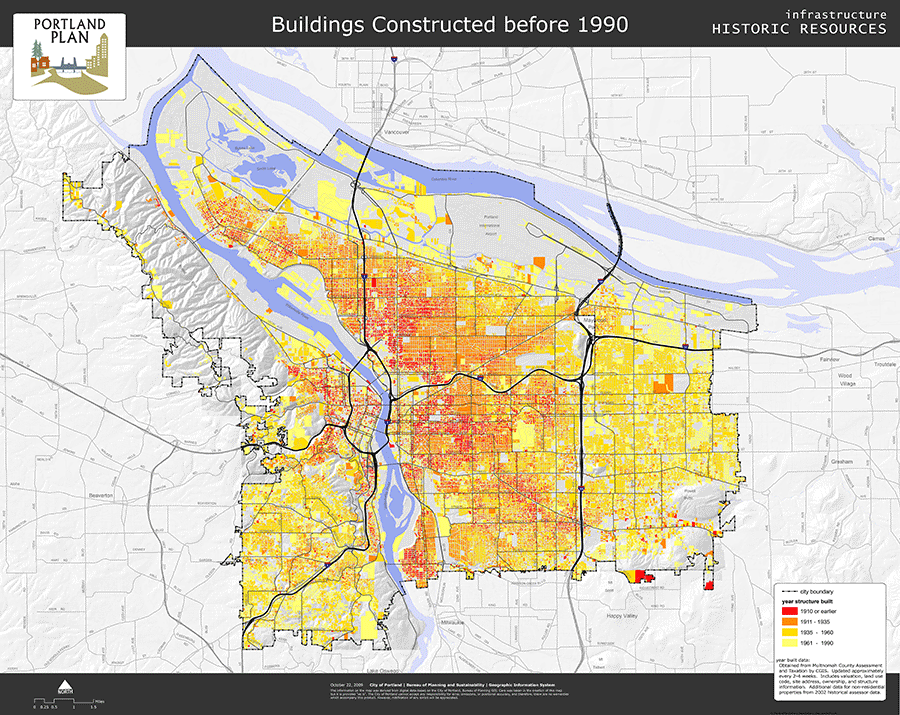
Portland Structures: Constructed before 1990 from Bureau of Planning and Sustainability
Unfortunately, the demand for housing and the support of high density development within inner Portland has led to the demolition of an increasing number of historic homes, from 73 single-dwellings in 2012 to 141 in 2014. (3) The market has also turned in favor of developers looking to turn a profit, and these financially-driven decisions are driving up larger, high density buildings. Currently, the Bureau of Development Services has no definition for demolition, which allows developers to define new construction as a renovation if any part of the building is kept, even just the foundation. Demolition of existing buildings usually is permitted with no design review if the project adheres to codes set in Portland’s 1979 Comprehensive Plan. (4)
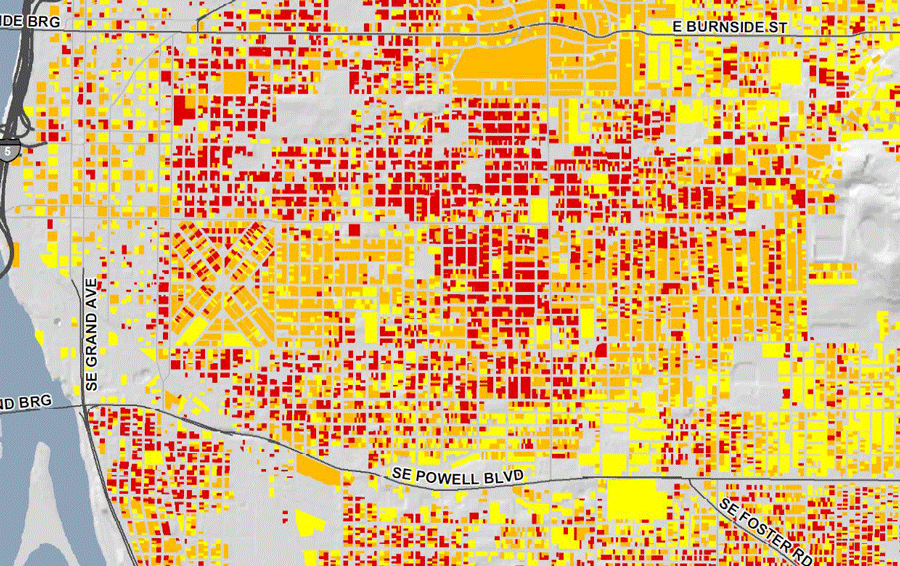
Enlarged image of earlier focused on Division St.
The lack of check and balances on new construction has the potential to destroy neighborhood character one house at a time. Portland has already started to lose affordable housing for young families and minorities, and this will continue if starter homes are replace with high end apartments and high scale houses. Not to mention, demolition includes destroying old growth timber, custom workmanship of skilled labor, and irreplaceable history. Developers and architects should be held accountable for whether new construction will be able to age within the surrounding neighborhood and have longevity of actual craftsmanship.
From a sustainability perspective, restoring an existing build is ‘greener’ than demolition. Restore Oregon claims 26% of the state’s landfill comes from demolition and construction waste and on average, 115 lbs/sqft of waste is generated from a demolition. Rehabilitation of a historic structure could mean 60% of costs go into the local labor market, according to Restore. (3) The Portland Coalition for Historic Resources and Architectural Heritage Center are proposing a plan to the Portland City Council that include requirements to call any project that brings down 50% or more of a structure a demolition, coupled with removal of a section of the building code that allows some properties to be demolished without proper notification and delay. In addition, establish a task force to identify additional building and zoning code improvements that would ensure demolitions are appropriately managed and that replacement construction responds to neighborhood characteristics. (5)
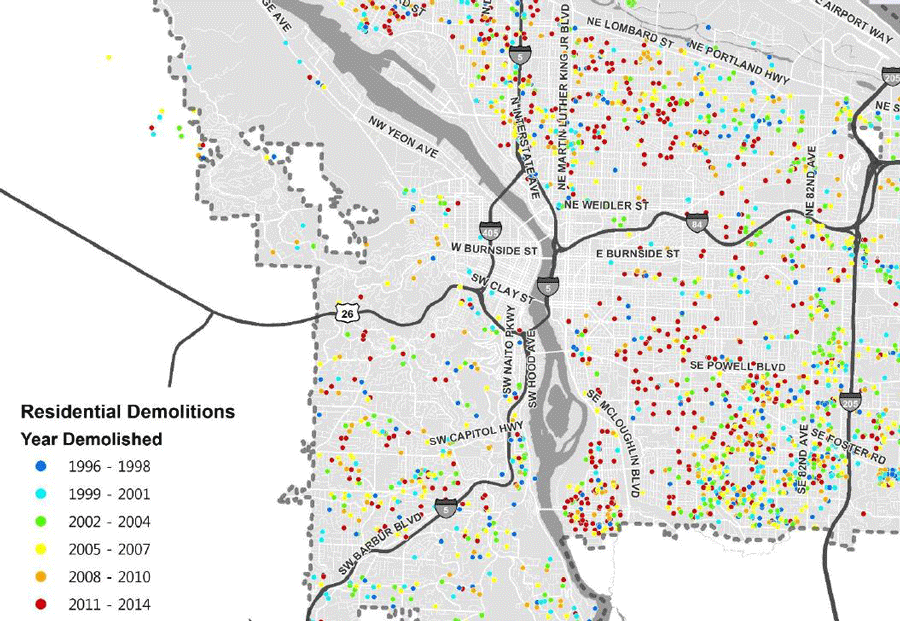
Residential Demolitions by year demolished
If new construction projects are abiding code and are past the planning stage of the land use processing, communities are left with little options other than to watch as a bystander. It is no longer in Portland code to protect solar access or give neighbors notice of new development. (2) There are loopholes in requirements to post and deliver notices about demolition. We need to hold renovations and new construction to a new standard of contextual awareness and long-lasting architectural visions that are incorporated into codes. If we continue allowing developers to build to the maximum height, maximum FAR, with little or no design review from community representatives, what will become of our neighborhoods? Heather Flint-Chatto of the Division Design Initiative brings up some important points when she states for the Southeast Examiner: “Will we continue to allow significant impacts such as lack of parking, loss of solar access and privacy, increased traffic, lack of respect for adjacent context or existing character and no real ability for neighborhoods to have meaningful and timely input on projects?” (2)
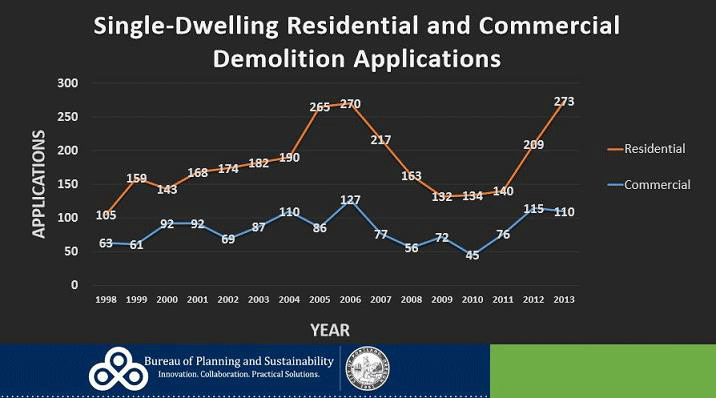
Single-dwelling residential and commercial demolition applications via BPS
Architecture for Humanity Portland is currently working with Division Design Initiative, a grass roots initiative to bring together a community vision and avenue actualization of its goals. This Initiative was created in response to the burst of housing development that has happened over the last 24 months. During the past year, as more than 8 high density housing projects have gone under construction, and Division’s neighborhood has felt the change. The Initiative has created a process that community leaders hope will engage neighbors and businesses to explore future design issues and concerns. This would include a toolbox of design guidelines for new development in the area, mapping of key sites/special places, and priorities for new development that is sensitive to existing character that supports economic growth and vitality. (1)
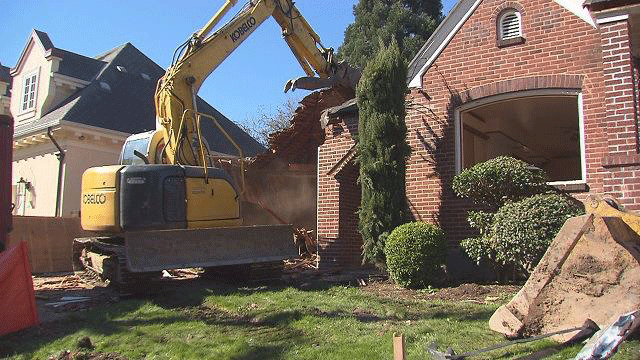
House being demolished on NE Alameda
SE Uplift and Architectural Heritage Center also have been working to promote communities that are livable, socially diverse, safe and vital. Southeast Uplift provides an organizational structure and forum to empower citizens to effectively resolve issues of livability and community development. (3)
Written by Hali Knight, Architect I
Sources:
1 Division Design Initiative. Accessed 8 Aug 2014
2 Hery, Karen. “Profits Trump Courtesy.” Southeast Examiner. February 1,2014.
3 Kellett, Bob. “The Whos and Whats of Home Demolitions.” Southeast Uplift Neighborhood Coalition. July 11, 2014.
4 Pierce, Midge. “Downside to density designs.” Southeast Examiner. March 1, 2014.
5 Portland Preservation. Bosco-Milligan Foundation/Architectural Heritage Center. Accessed 8 Aug 2014 http://portlandpreservation.wordpress.com/
6 Njus, Elliot. “Apartment Market Grows Tighter,” The Oregonian. April 17, 2013. < http://www.oregonlive.com/front-porch/index.ssf/2013/04/apartment_market_grows_tighter.html>
